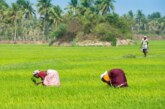by Shweta Tyagi, Chief Functionary, India Water Foundation

Biodiversity (biological diversity), is the abundance of living things that make up life on Earth (UNEP, 2020). Biodiversity ensures that we have fertile soil, as well as a variety of foods, including fruits and vegetables that we should eat. It is the basis of many of our industries and livelihoods and helps to control climate change by storing carbon and rain control. It also filters our air and water and reduces the impact of natural disasters such as landslides and coastal storms.The environment is also an important source of many medicines used in modern medicine.(UNEP, 2020)When the diversity of biodiversity is high, the rate of infection of some zoonotic diseases can be reduced (WHO, 2015).Biodiversity also supports economic prosperity, about US $ 44 trillion in economic profits – representing more than half of global GDP – depend on or to a lesser extent on their environment and services.(World Economic Forum, 2020).

Climate change alters ecosystems and its affects can be seen in individual species and how they interact with their components of ecosystem, it’s an ever-growing threat to us humans and also to the natural biodiversity and ecosystems.We are losing 1,000 times more species than ever before in recorded human history and one million species are at risk of extinction.(ipbes, 2019). In artic region, ecosystem that lives in these parts which requires the ice for protection and formation of food are greatly affected by rising temperatures melting the ice. (WWF, 2020). The CO2in the air dissolves into the ocean water which makes it more acidic.(Feely, 2009) This affects plants and the ability of animals in the sea to make shells and skeletons of calcium carbonate, while dissolving shells already formed. The increase in ocean acidity leads to a phenomenon known as coral bleaching.(Brown, 1997). Due to climate change, there can be lesser amount of soil moisture due to lesser rainfall, higher temperatures or there could be lesser nutrients available in the soil affecting the floral life on earth. (Das, 2016).
The air we breathe, the water we drink and the food we eat all rely on biodiversity, but right now it is in crisis –because of us. What does this mean for our future and can we stop this?Life on Earth has suffered five mass extinctions of biodiversity in its long history, caused by massive volcanic eruptions, deep ice ages, meteorite impacts and clashing continents. But some scientists believe a sixth mass extinction has now begun. This one is very different, caused not by geology or natural climate change, but by a single species – us. Humans and our livestock now consume 25-40% of the planet’s entire “primary production”, i.e the energy captured by plants on which all biodiversity depends. For many people living in towns and cities, wildlife is often something you watch on television. But it is closely linked to our very essence of life. For example, without plants there would be no oxygen and without bees to pollinate there would be no fruit or nuts. When scientists explore each ecosystem, they find countless such interactions, all honed by millions of years of evolution. If undamaged, this produces a finely balanced, healthy system which contributes to a healthy sustainable planet. Many new medicines are harvested from nature, such as a fungi that grows on the fur of sloths and can fight cancer. About 1.7 million species of animals, plants and fungi have been recorded, but there are likely to be 8-9 million and possibly up to 100 million. The concern is that many species are being lost before we are even aware of them, or the role they play in the circle of life.
The effects of climate change present significant challenges to current conservation approaches. Temperature changes will interact with existing drivers such as loss of space to affect the distribution of species even though they are protected within the set boundaries.(Shannon M Hagermancorresponding, 2009). As a result of changes in the distribution of species, some people and species will no longer work in the repositories created for their protection. In past 5 years research have shown that climate change is resulting in phenology, net-primary production and interacting among species, effects of these can be observed on above and below the ground(Rinnan RA, 2007). Additionally, modified interference regimes can increase the ability of invasive plant species to colonize.(Hobbs RJ, 1992).
To mitigate these uncertainties, the most common proposed conservation approach is to extend the linked network of protected areas including migration routes(Hannah L, 2002), it is most important for adaptation to ecosystems during the transition, higher risk areas can facilitate species diversity by promoting global and ocean movement; they can also strengthen the distribution of species on good scales.(RF., 2001) With their geographical locations and protection levels changing from time to time This approach can be particularly useful in areas where there are limited spatial opportunities available in new protected areas.(Shannon M Hagermancorresponding, 2009).
Nature based solutions including, site-specific natural and cultural contexts that include traditional, local and scientific knowledge can be very helpful in conservating biodiversity.(Cohen-Shacham, 2016). These solutions include using the current natural ecosystem, then restoring or manage the system to create a new ecosystem for maximising ecosystem services. (Linjun Xie, 2020). In a flood prone area, the combination of restoration of watershed with conventional measure like barriers will help in mitigating flood risk as well as support biodiversity. Restoring forest is useful in economic-biodiversity while sustainable agriculture like rice-paddy agriculture helps to conserve rapidly degrading wetland, its biodiversity and improve local economy. (Yoon, 2009).
The path to biodiversity conservation while keeping in mind the growing impacts of climate change is onerous, we can achieve it by integrating climate change adaptation activities across sectors with conceptual models, feasibility evaluation and implantation plans which are not focused on static targets and incorporating them with vulnerability studies for new policies and action plans at local, regional and global level.Could the loss of biodiversity be a greater threat to humanity than climate change? Yes –Changes to the climate are reversible, even if that takes centuries or millennia. But once species become extinct, particularly those unknown to science, there’s no going back. Making sustainable choices and responsible consumption addresses the environmental footprint. It’s now or never to give nature the space and protection, it needs because we are part of the solution.
References
Brown, B. E. (1997). “Coral bleaching: causes and consequences.” . Coral reefs , 16, no. 1 : S129-S138.
Cohen-Shacham, E. G. (2016). “Nature-based solutions to address global societal challenges.” . IUCN: Gland, Switzerland , 97.
Das, M. V. (2016). “Impact of climate change on medicinal and aromatic plants.” . Indian J Agric Sci 86, no. 11, 1375-1382.
Feely, R. A. (2009). “Ocean acidification.”. Oceanography, 22, no. 4 : 36-47.
Forum, W. E. (2020). Nature Risk Rising:Why the Crisis Engulfing Nature Matters for Business and the Economy.
Hannah L, M. G. (2002). Climate change-integrated conservation strategies. . Global Ecol Biogeogr. .
Hobbs RJ, H. L. (1992). Disturbance, diversity and invasion: implications for conservation. . Conserv Biol. , 6:324–37. .
ipbes, S. D. (2019). Summary for policymakers of the global assessment report on biodiversity and ecosystem services of the Intergovernmental Science, . Policy Platform on Biodiversity and Ecosystem Services, 56.
Linjun Xie, H. B. (2020). Nature-based solutions for urban biodiversity governance. Environmental Science & Policy, VOL10, 77-87.
RF., N. (2001). Beyond Kyoto: Forest management in a time of rapid climate change. . Conserv Biol. , 15:578–90.
Rinnan RA, M. A. (2007). Fifteen years of climate change manipulations alter soil microbial communities in a subarctic heath ecosystem. . Glob Change Biol. , 13:28–39.
Shannon M Hagermancorresponding, K. M. (2009). Climate change and biodiversity conservation: impacts, adaptation strategies and future research directions. F1000 Biol Rep, 1-16.
UNEP. (2020, 5 21). Biodiversity: our solutions are in nature.
WHO. (2015, 6 3). Biodiversity and Health.
WWF. (2020). Effects of climate change on arctic ecosystems. Factsheets, 4.
Yoon, C. G. (2009). “Wise use of paddy rice fields to partially compensate for the loss of natural wetlands.” . Paddy and Water Environment 7, no. 4 , 357-366.


